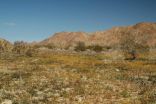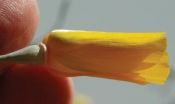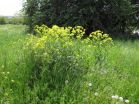(Press-News.org) Who said that there is only sand in the deserts? Not quite desert roses, two new species of desert poppies from North America prove such statements wrong with their simple beauty. The newly described plants are found in the deserts of California and Arizona and have a vibrant yellow colored inflorescences, typical for all the desert dwellers from the Eschscholzia genus of the poppy family. The study was published in the open access journal PhytoKeys.
Most commonly known for the iconic California Poppy, the state flower of California, Eschscholzia is a genus in the poppy family Papaveraceae that previously held 12 species. The genus is native to the mainland and islands of western North America in both the United States and Mexico, but the type species, Eschscholzia californica, is commonly spread and has invaded Mediterranean regions around the world.
Shannon Still discovered the new species while studying Eschscholzia for his dissertation research at the University of California Davis. "What is interesting about these new species is that, while people have been collecting these plants for decades, they were not recognized as something different" Still said. "They were always confused for existing species. This confusion led to my study of the group, and ultimately, recognizing something new. I imagine there are many more desert plant species that are also understudied."
The two new desert species E. androuxii and E. papastillii are found in desert washes, flats, and slopes growing in coarse and sandy soil across California deserts and parts of Arizona. Eschscholzia androuxii has a small range, is fairly uncommon and is suggested that it be listed as a rare plant species. The wide distribution of the other species, suggests there are no conservation threats at the moment.
Still acknowledges the resources that lay the foundation for his research. "My work would have been impossible without a strong system of specimen and data sharing from herbaria around the world, and especially in California. I used the herbarium specimens to compare with collections I had made from the field, to establish important characters used to identify the species, and to examine the species' geographic ranges. This work highlights the value that herbarium collections play in cataloging, understanding and conserving our biological diversity."
INFORMATION:
Original Source:
Still SM (2014) Two new desert Eschscholzia (Papaveraceae) from southwestern North America. PhytoKeys 35: 45. doi: 10.3897/phytokeys.35.6751
California and Arizona amaze with 2 new species of desert poppy
2014-03-11
ELSE PRESS RELEASES FROM THIS DATE:
Exotic plant species alter ecosystem productivity
2014-03-11
This news release is available in German.
Halle, Germany/ Missoula, USA/ Berkeley, USA. In their joint publication in the journal „Ecology Letters" German and American biologists have reported an increase in biomass production in ecosystems colonised by non-native plant species. In the face of climate change, these and other changes to ecosystems are predicted to become more frequent, according to the researchers.
All over the world, plant and animal species are increasingly encroaching upon ecosystems where they don't belong as a result of human influence. This ...
Getting hyperspectral image data down to a sprint
2014-03-11
Cameras with hyperspectral sensors can observe far more than the human eye. Unlike the retina, which has only three color receptors (red, green and blue), these sensors can generate 130 different color values per pixel. Using this high-grade color resolution, an entire range of different materials can be differentiated impeccably – even if, at first glance, they appear the same to the human eye. This is because every substance has its own individual color spectrum, irrespective of how its surface reflects the light hitting it. This hyperspectral technology can be used anyplace ...
Study finds CT scans predict chemotherapy response in pancreatic cancer
2014-03-11
Computed tomography (CT) scans routinely taken to guide the treatment of pancreatic cancer may provide an important secondary benefit. According to new research from The University of Texas MD Anderson Cancer Center, the scans also reflect how well chemotherapy will penetrate the tumor, predicting the effectiveness of treatment.
The research, published in the Journal of Clinical Investigation, is the first human study to address the issue of chemotherapy delivery to pancreatic tumors, a problem previously shown in animal studies.
"We found that the distribution of intravenous ...
Filling out those employment questionnaires might reveal more than you think
2014-03-11
Your answers on psychological questionnaires, including some of the ones that some employers give their employees, might have a distinct biological signature. New research indeed demonstrates overlap between what workers feel and what their bodies actually manifest. This is an important occupational health issue when we consider that workplace stress is the leading cause of sick leave related to depression and burnout. Involving over 400 workers from 35 businesses, the research was conducted by the researchers at the University of Montreal, its affiliated Institut universitaire ...
Success of new bug-fighting approach may vary from field to field
2014-03-11
CHAMPAIGN, Ill. — A new technique to fight crop insect pests may affect different insect populations differently, researchers report. They analyzed RNA interference (RNAi), a method that uses genetic material to "silence" specific genes – in this case genes known to give insect pests an advantage. The researchers found that western corn rootworm beetles that are already resistant to crop rotation are in some cases also less vulnerable to RNAi.
The study is reported in the journal Pesticide Biochemistry and Physiology.
"Our results indicate that the effectiveness of ...
Excessive deer populations hurt native plant biodiversity
2014-03-11
PITTSBURGH—Too much garlic mustard in your neighborhood forest? Actually, the problem may be too many deer.
A research team led by Susan Kalisz, professor of evolutionary ecology in the University of Pittsburgh's Department of Biological Sciences, published a paper online today in the Proceedings of the National Academy of Sciences that takes a long view on why invasive garlic mustard plants thrive to the detriment of native species.
The study, initiated in 2003 at the Trillium Trail Nature Reserve in Fox Chapel, Pa., concludes that an overpopulation of deer (density ...
The business of fear: Can our favorite products provide emotional support?
2014-03-11
Worried that you could be in a car accident? Insurance company X can protect you and your family. Afraid you will lose your children to drunk driving? MADD can help you educate them to avoid drinking and driving. According to a new study in the Journal of Consumer Research, when a person-to-person support system is not available in a fearful situation, brands can act as a replacement source of emotional attachment.
"We look at how fear can impact evaluations of a new brand," write authors Lea Dunn and JoAndrea Hoegg (both University of British Columbia). "Our research ...
They're grrrreat! How do brands create loyalty that lasts a lifetime?
2014-03-11
From a very young age, children are targeted with advertising messages that emphasize fun and happiness, especially for food products and toys. But what happens to these beliefs once the child is grown? According to a new study in the Journal of Consumer Research, children develop brand loyalty and biases that carry over into their adult lives and are often difficult to change.
"Our research provides an initial investigation into how exposure to ads in childhood can lead to enduring biases that favor products associated with the ads once the kids grow up," write authors ...
Gift giving 101: When do 'perfect' gifts backfire?
2014-03-11
When it comes to shopping for gifts, we try to select things we think people both want and need. According to a new study in the Journal of Consumer Research, focusing too much on the gift recipient can lead to giving the gift we were trying to avoid in the first place.
"We predict that in a gift-giving situation, both the gift givers and gift receivers will focus on the gift receivers when thinking about the gift. Givers will choose gifts that are more desirable over gifts that are more practical, whereas receivers will give greater weight to the gift's practicality," ...
LSU research shows face matching for passports and IDs incredibly fallible
2014-03-11
BATON ROUGE – New research finds face matching, as when customs agents check passports, to be incredibly fallible, with error rates between 10 and 20 percent under ideal, laboratory-induced conditions, and much worse in more realistic settings.
"Because society relies on face perception and ID verification for many tasks, people are often under the impression that we are experts in this domain," said LSU Assistant Professor of Psychology Megan Papesh. "Our research shows the precise opposite."
In a recent article published in Attention, Perception, and Psychophysics, ...





